Development and Validation of Overpressure Response Model in Steel Tunnels Subjected to External Explosion
Abstract
1. Introduction
2. Analytical Model
2.1. Near-Surface Burst Experiments
2.2. External Tunnel Explosion Tests
2.3. Numerical Simulation
3. Results and Discussion
3.1. Near-Surface Burst Experiments
3.2. Portal Overpressure
3.3. Internal Tunnel Overpressure
3.4. Numerical Simulation Results
3.5. Establishing the Predictive Model of Tunnel Overpressure
- 1.
- Method I:
- (1)
- Use Equation (6) in Section 3.1 to determine the overpressure of near-surface burst ()
- (2)
- Use Equation (8) in Section 3.2, which indicates that the blast pressure at the portal is 1.17 times greater than the near-surface burst, to determine the portal pressure ().
- (3)
- Use Equation (9) in Section 3.3, which indicates the relation between the peak pressures measured by each pressure sensor and at the portal section, to determine the overpressure ratio ().
- (4)
- Use Equation (11) to determine the in-tunnel pressure ().
- 2.
- Method II:
- (1)
- By using Equation (7) in Section 3.2, which indicates the power regression equation ofblastpressure at the portal, the portal pressure () may be determined.
- (2)
- Use Equation (9) in Section 3.3, which indicates the relation between the peak pressures measured by each pressure sensor and at the portal section, the overpressure ratio () may be determined.
- (3)
- Use Equation (11) to determine the in-tunnelpressure ().
- 3.
- Method III:
- (1)
- By using Equation (10) in Section 3.4, which indicates the polynomial regression equation of the verification of combined numerical simulations and prediction models, the blast pressure atthe portal () may be predicted.
- (2)
- Use Equation (9) in Section 3.3, which indicates the relation between the peak pressuresmeasured by each pressure sensor and at the portal section, to determine the overpressure ratio ().
- (3)
- Use Equation (11) to determine the in-tunnel pressure ().
4. Conclusions
Author Contributions
Funding
Conflicts of Interest
References
- Smith, P.D.; Vismeg, P.; Teo, L.C.; Tingey, L. Blast wave transmission along rough-walled tunnels. Int. J. Impact Eng. 1998, 24, 419–432. [Google Scholar] [CrossRef]
- Yu, W.F.; Hung, C.W.; Cheng, D.S. Effect of Subdividing Stacks on Blast Overpressure from Explosion inside Ammunition Storage Magazine. J. Explos. Propellants 2008, 24, 25–40. [Google Scholar]
- Luccioni, B.; Ambrosini, D.; Nurick, G.; Snyman, I. Craters produced by underground explosions. Comput. Struct. 2009, 87, 1366–1373. [Google Scholar] [CrossRef]
- Yu, W.F.; Hung, C.W.; Cheng, D.S. Effect of Blast wall on Safety Distance of Ammunition Storage Magazine Subjected to Internal Explosion. J. Chung Cheng Inst. Technol. 2010, 39, 131–145. [Google Scholar]
- Cheng, D.S.; Hung, C.W. Experiment and Numerical Simulation of Peak Overpressure of C4 Explosives in the Airblast. J. Explos. Propellants 2010, 26, 75–96. [Google Scholar]
- Pi, S.J.; Cheng, D.S.; Cheng, H.L.; Li, W.C.; Hung, C.W. Fluid-Structure- Interaction for a Steel Plate subjected to Non-Contact Explosion. Theor. Appl. Fract. Mech. 2012, 59, 1–7. [Google Scholar] [CrossRef]
- Zakrisson, B.; Wikman, B.; Häggblad, H.Å. Numerical simulations of blast loads and structural deformation from near-field explosions in air. Int. J. Impact Eng. 2011, 38, 597–612. [Google Scholar] [CrossRef]
- Scheklinski-Gluck, G. Blast in Tunnels and Rooms from Cylindrical HE-Charges outside the Tunnel Entrance. In Proceedings of the Sixth International Symposium on Interaction of Nonnuclear Munitions with Structures, Panama City Beach, FL, USA, 3–7 May 1993. [Google Scholar]
- McMahon, G.W.; Taylor, S.R. In-Tunnel Airblast from Near Portal Detonations; ERDC Report; ERDC: Vicksburg, MS, USA, 2005. [Google Scholar]
- Welch, B.; McMahon, G.W.; Kim, D. Transportation Tunnels and Terrorist Attacks; ERDC: Vicksburg, MS, USA, 2005. [Google Scholar]
- LS-DYNA. Version 971/Rev 5 User’s Manual; Livermore Software Technology Corporation: Livermore, CA, USA, 2010. [Google Scholar]
- Pricop, M.V.; Wang, B.; Rehn, W. Fluid-Structure-Interaction for the Detonation of a Gaseous Mixture in a Nuclear Reactor Containment; Institute National de Cercetari Aerospatiale: Bucharest, Romania, 2002. [Google Scholar]
- Mullin, M.J.; O’Toole, B.J. Simulation of Energy Absorbing Materials in Blast Loaded Structures. In Proceedings of the 8th Internation LS-DYNA Users Conference, Dearbon, MI, USA, 2–4 May 2004; pp. 67–80. [Google Scholar]
- Dobratz, B.M. LLNL Explosives Handbook Properties of Chemical Explosives and Explosives Simulants; Lawrence Livermore National Laboratory: Livermore, CA, USA, 1981; pp. 8–23. [Google Scholar]
- Wang, J. Simulation of Landmine Explosion Using LS-DYNA 3D Software: Benchmark Work of Simulation of Explosion in Soil and Air; DSTO-TR-1168; Aeronautical and Maritime Research Laboratory: Fishermans Bend, Australia, 2001; pp. 1–30. [Google Scholar]
- Gebbeken, N.; Ruppert, M. On the Safety and Reliability of High Dynamic Hydrocode Simulations. Int. J. Numer. Methods Eng. 1999, 46, 839–851. [Google Scholar] [CrossRef]
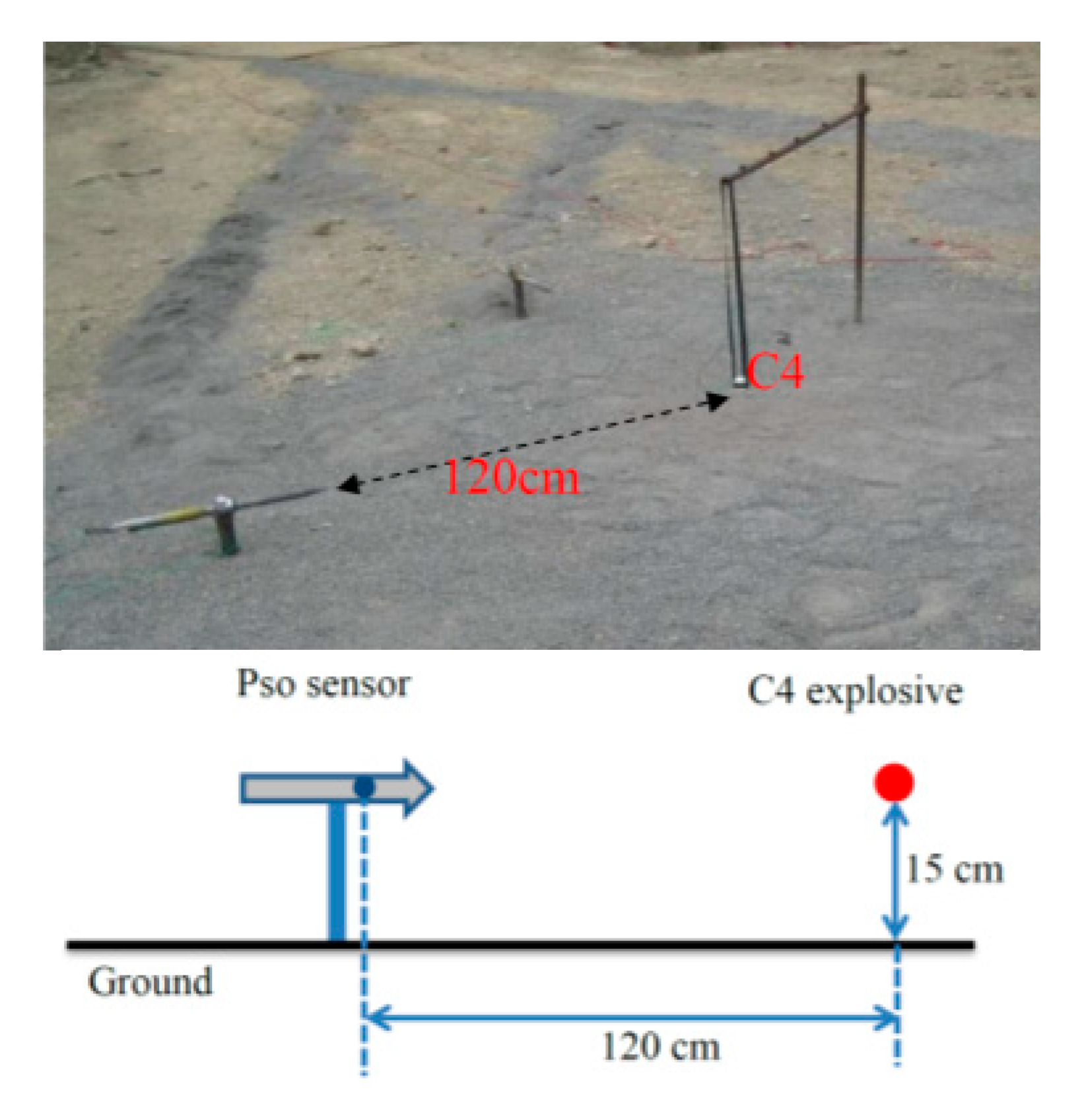

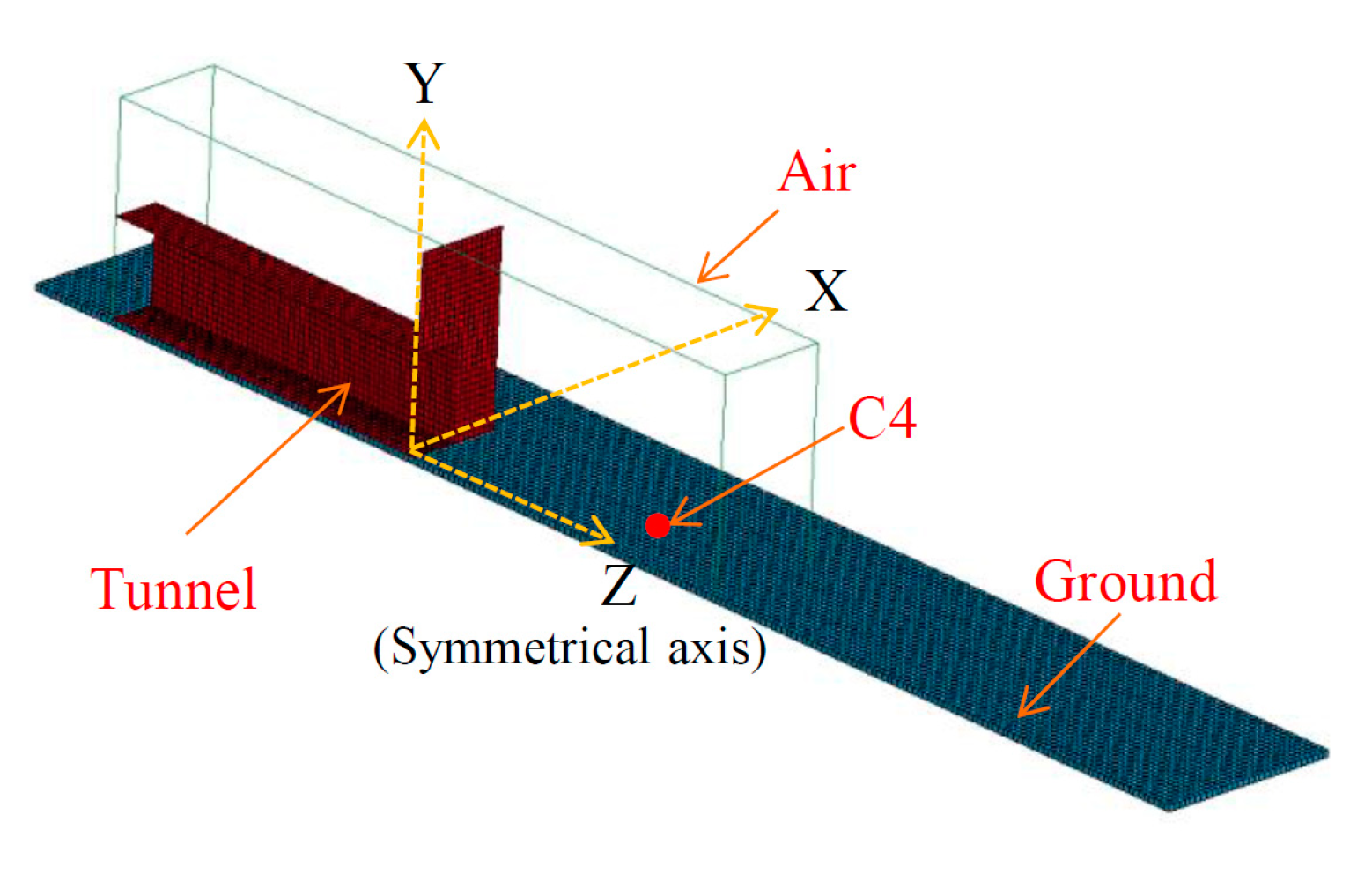
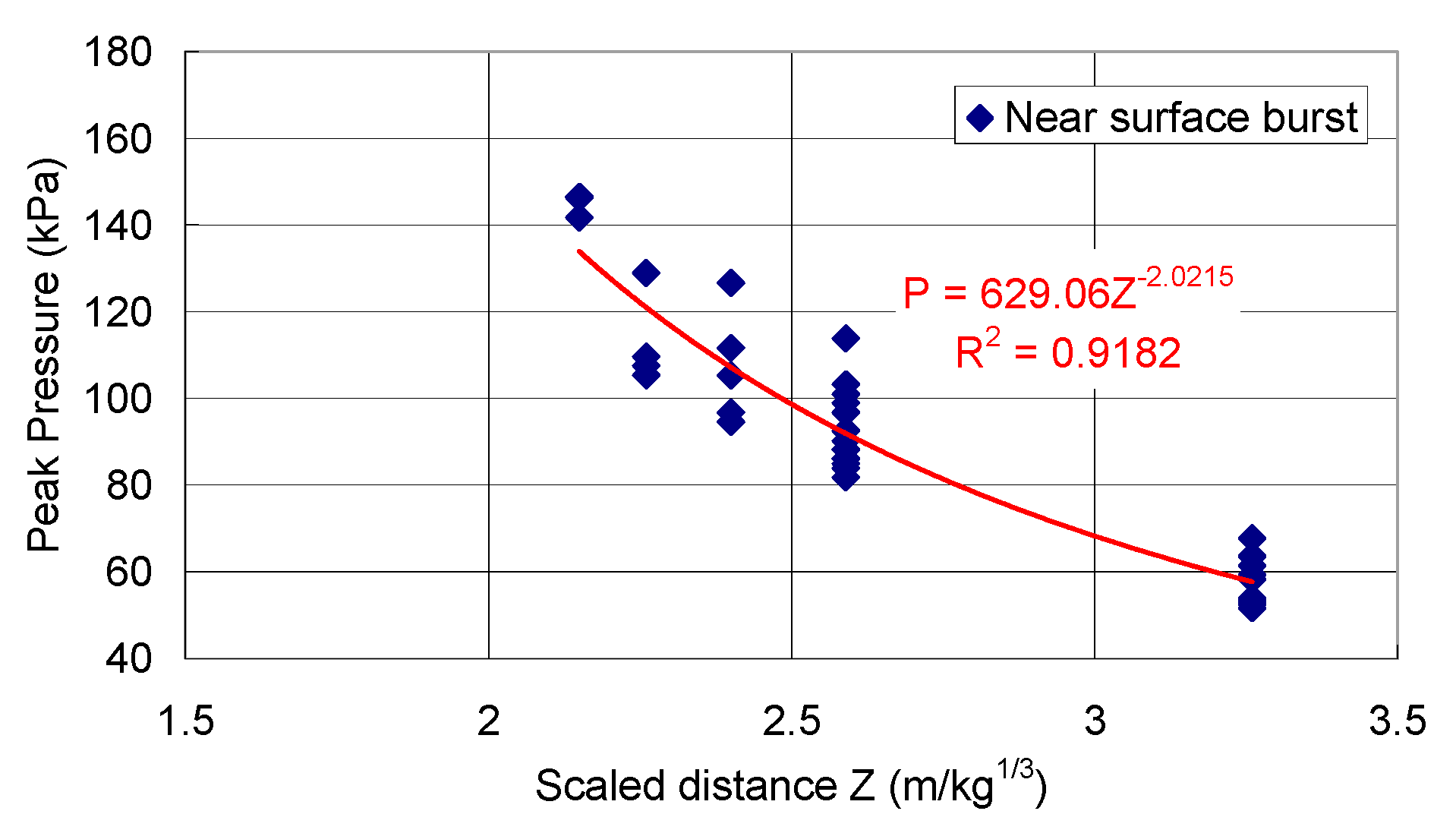
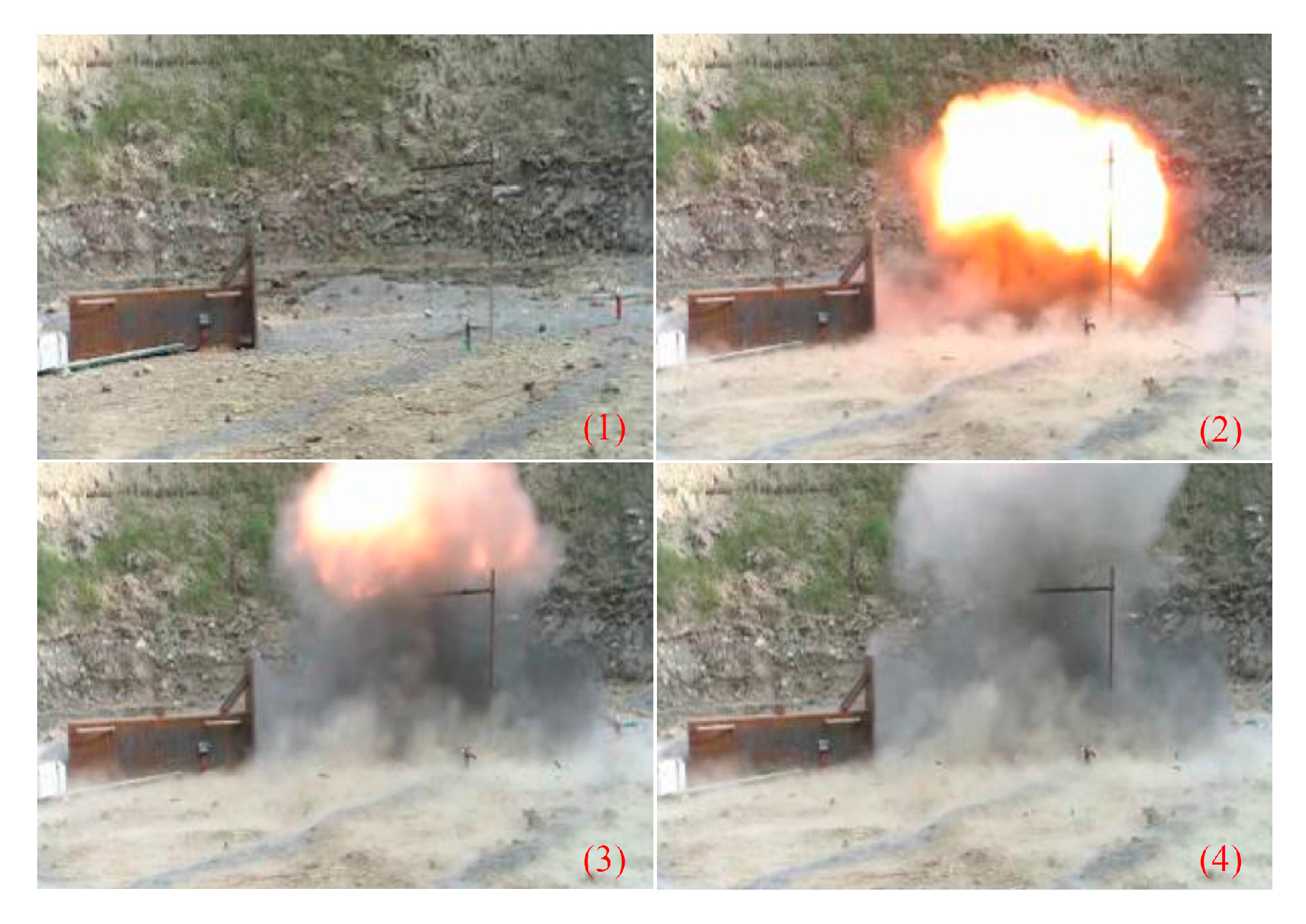

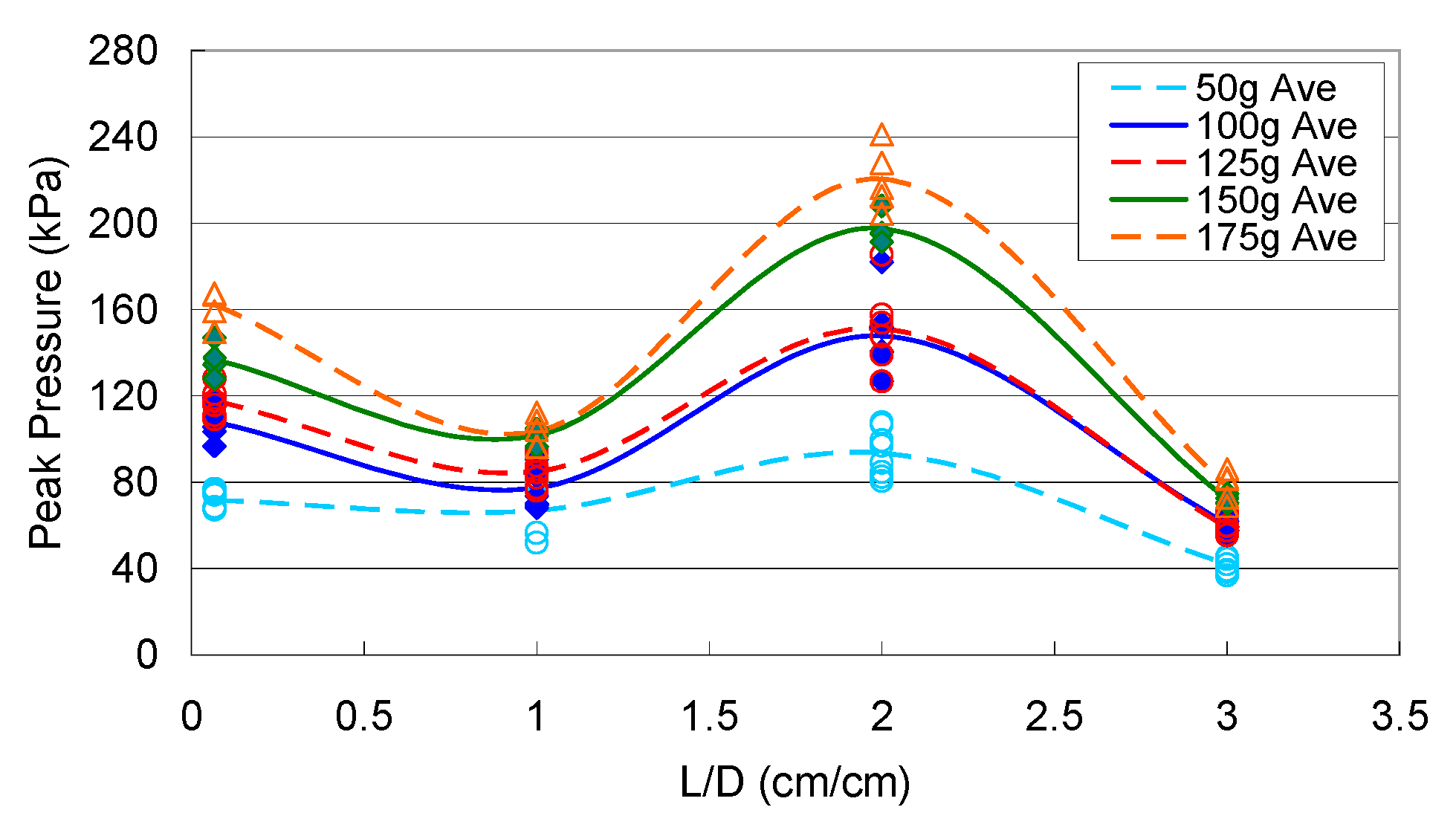
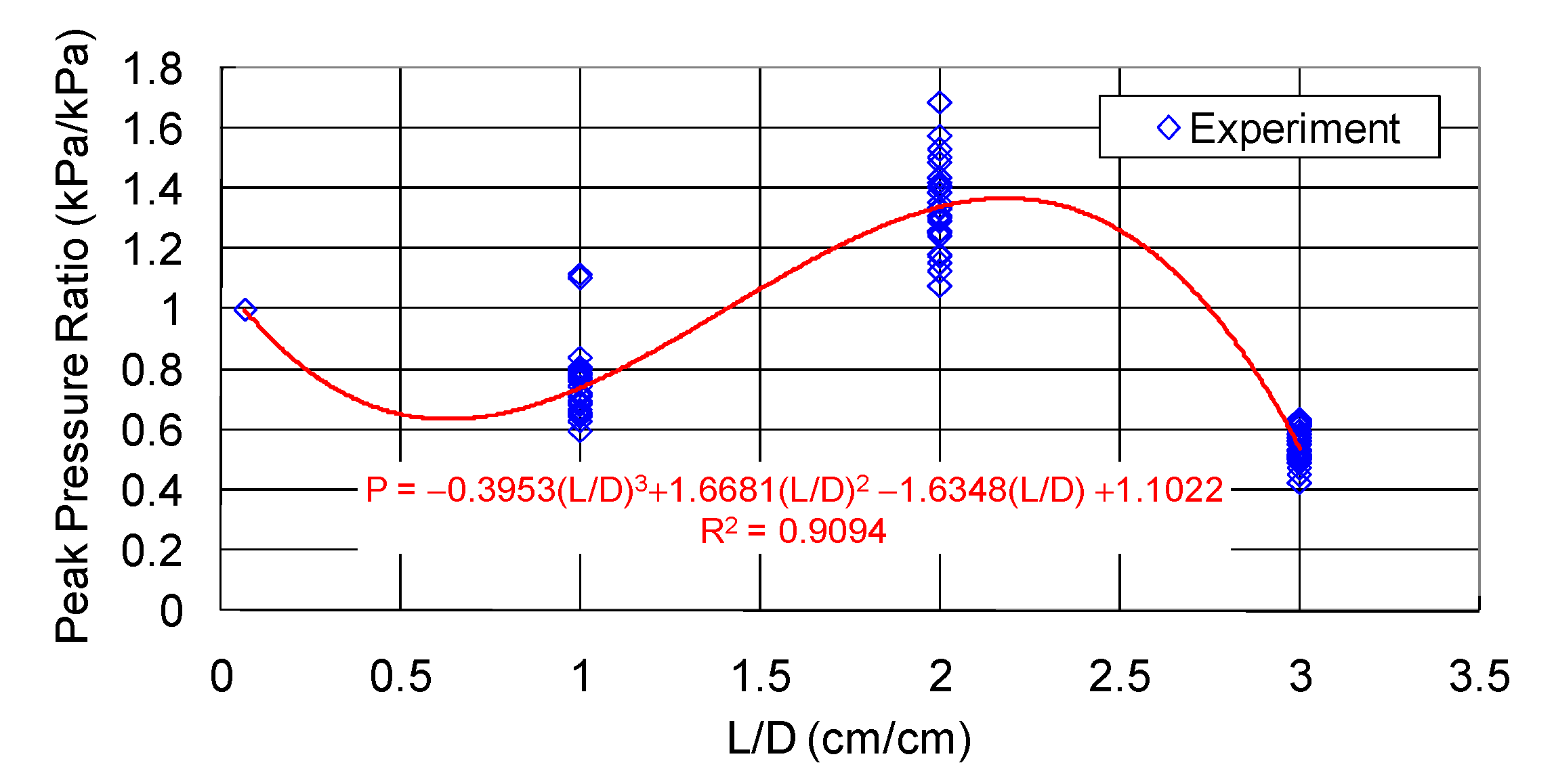
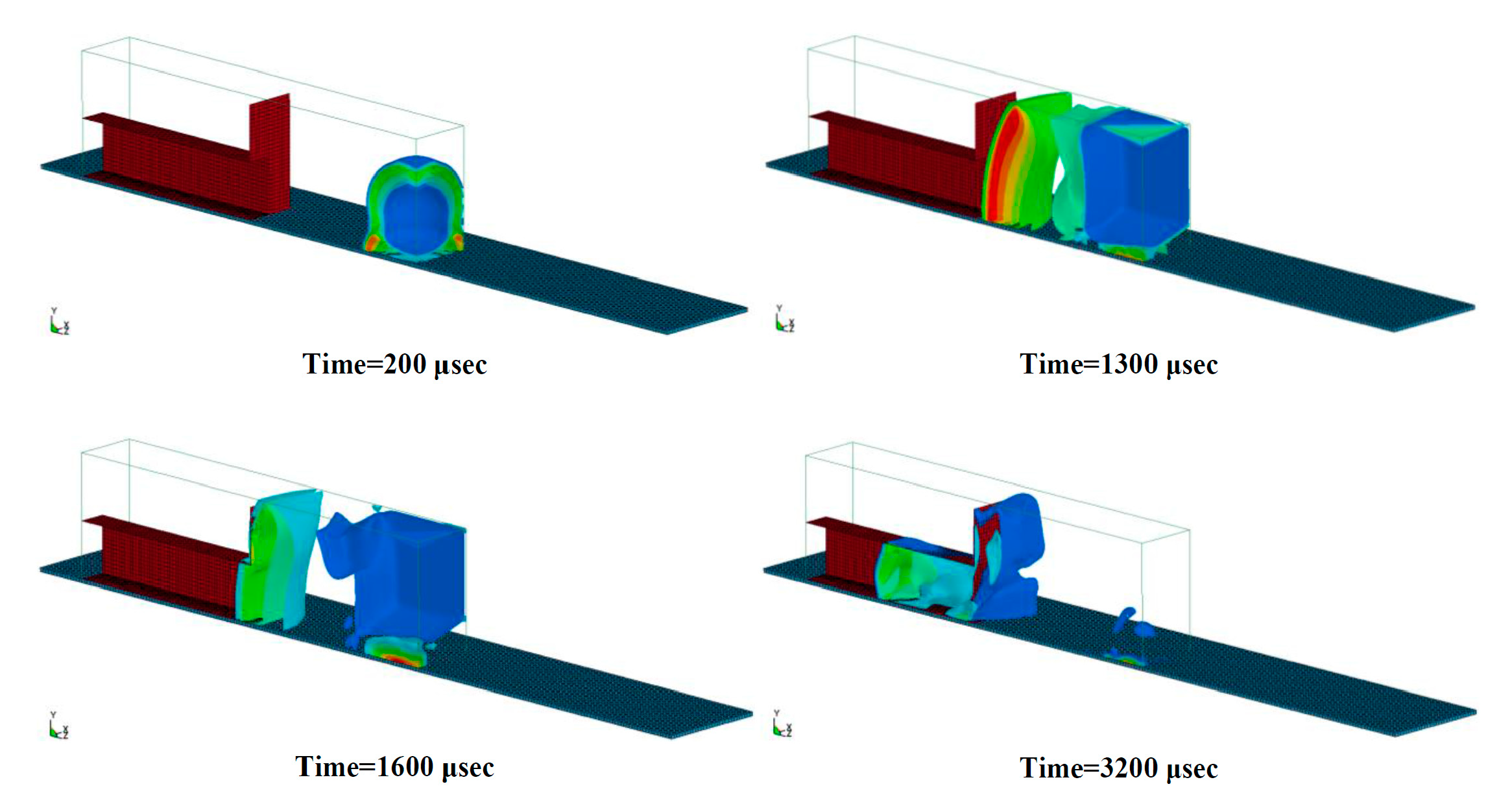
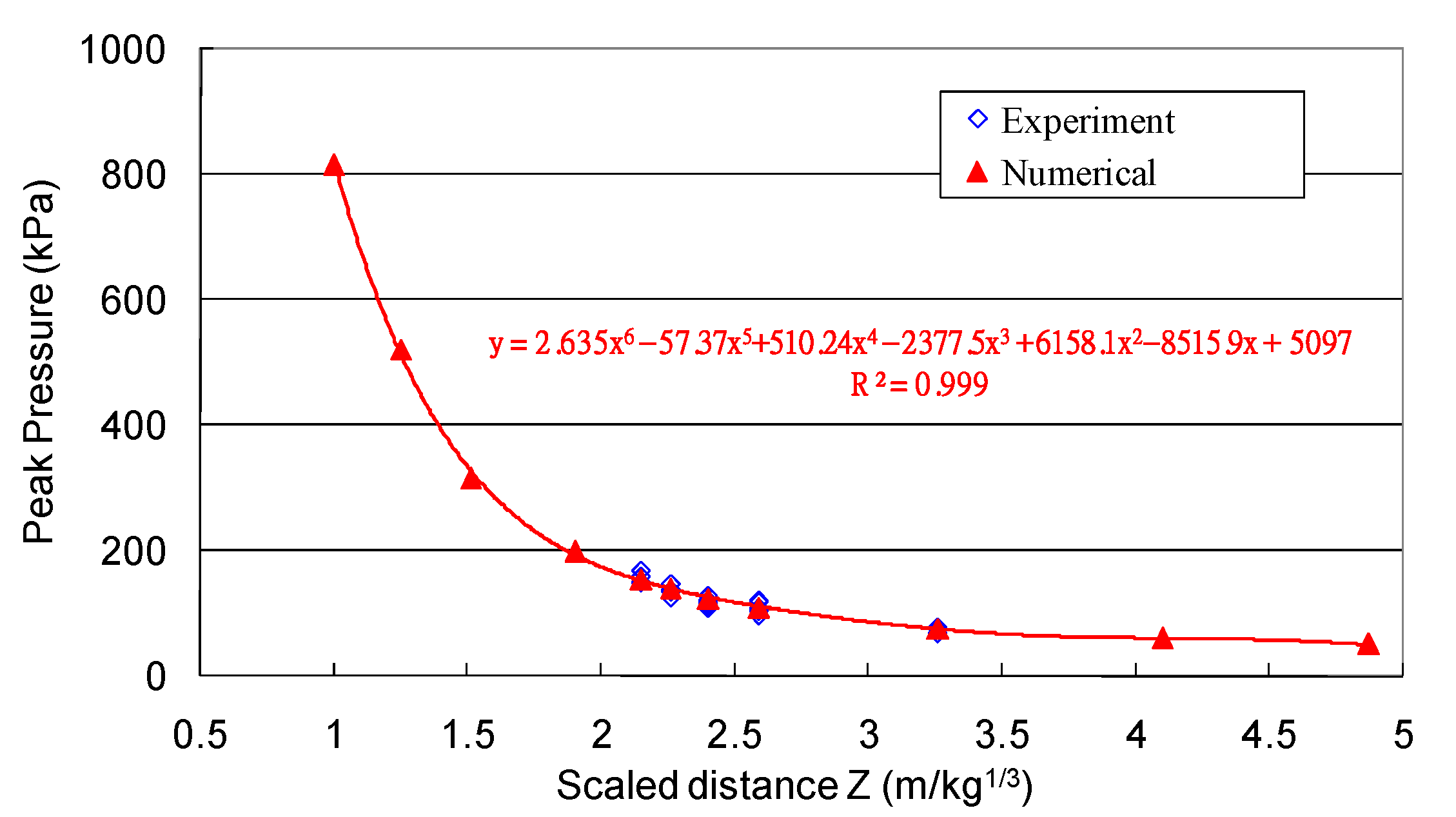
| Air [13] MAT_NULL, EOS_LINEAR_POLYNOMINAL | |||||||||
| C0 | C1 | C2 | C3 | C4 | C5 | C6 | E0 | ||
| (g/cm3) | (Mbar) | ||||||||
| 1.29 × 10−3 | 0 | 0 | 0 | 0 | 0.4 | 0.4 | 0 | 2.5 × 10−6 | |
| Explosive [14] MAT_HIGH_EXPLOSIVE, EOS_JWL | |||||||||
| D | PCJ | A | B | R1 | R2 | E0 | V0 | ||
| (g/cm3) | (cm/μs) | (Mbar) | (Mbar) | (Mbar) | (Mbar) | ||||
| 1.601 | 0.819 | 0.28 | 6.097 | 0.1295 | 4.5 | 1.4 | 0.25 | 0.09 | 1.0 |
| Tunnel [15] MAT_PLASTIC_KINEMATIC | |||||||||
| E | PR | SIGY | |||||||
| (g/cm3) | (Mbar) | (Mbar) | |||||||
| 8.0 | 2.03 | 0.3 | 2.2 × 10−3 | ||||||
| Soil Ground [15] MAT_RIGID | |||||||||
| E | PR | ||||||||
| (g/cm3) | (Mbar) | ||||||||
| 1.8 | 2.0 × 10−3 | 0.498 | |||||||
| Z | Pso | Standard Deviation | Coefficient of Variation |
|---|---|---|---|
| (m/kg1/3) | (kPa) | (kPa) | (%) |
| 3.26 | 57.97 | 5.06 | 8.73 |
| 2.59 | 92.81 | 8.53 | 9.19 |
| 2.40 | 106.97 | 12.98 | 14.80 |
| 2.26 | 113.37 | 9.97 | 8.96 |
| 2.15 | 143.61 | 2.53 | 1.76 |
| Z | Pso | Standard Deviation | Coefficient of Variation |
|---|---|---|---|
| (m/kg1/3) | (kPa) | (kPa) | (%) |
| 3.26 | 71.66 | 4.25 | 5.93 |
| 2.59 | 107.84 | 8.09 | 7.50 |
| 2.40 | 117.64 | 6.47 | 5.50 |
| 2.26 | 135.97 | 9.12 | 6.71 |
| 2.15 | 162.04 | 7.84 | 4.84 |
| Z | Pso | Pportal | Difference *1 | Ratio *2 |
|---|---|---|---|---|
| (m/kg1/3) | (kPa) | (kPa) | ||
| 3.26 | 57.97 | 71.66 | −19.10 | 1.24 |
| 2.59 | 92.81 | 107.84 | −13.94 | 1.16 |
| 2.40 | 106.97 | 117.64 | −9.07 | 1.10 |
| 2.26 | 113.37 | 135.97 | −18.09 | 1.22 |
| 2.15 | 143.61 | 162.04 | −11.37 | 1.13 |
| Z | PLS-DYNA | Pportal | Difference |
|---|---|---|---|
| (m/kg1/3) | (kPa) | (kPa) | (%) |
| 3.26 | 75.81 | 71.66 | 5.79 |
| 2.59 | 108.45 | 107.84 | 0.57 |
| 2.40 | 123.39 | 117.64 | 4.89 |
| 2.26 | 139.59 | 135.97 | −0.28 |
| 2.15 | 154.48 | 162.04 | −4.67 |
© 2020 by the authors. Licensee MDPI, Basel, Switzerland. This article is an open access article distributed under the terms and conditions of the Creative Commons Attribution (CC BY) license (http://creativecommons.org/licenses/by/4.0/).
Share and Cite
Hung, C.-W.; Lai, H.-h.; Shen, B.-C.; Wu, P.-W.; Chen, T.-A. Development and Validation of Overpressure Response Model in Steel Tunnels Subjected to External Explosion. Appl. Sci. 2020, 10, 6166. https://doi.org/10.3390/app10186166
Hung C-W, Lai H-h, Shen B-C, Wu P-W, Chen T-A. Development and Validation of Overpressure Response Model in Steel Tunnels Subjected to External Explosion. Applied Sciences. 2020; 10(18):6166. https://doi.org/10.3390/app10186166
Chicago/Turabian StyleHung, Cheng-Wei, Hsin-hung Lai, Bor-Cherng Shen, Pin-Wen Wu, and Tai-An Chen. 2020. "Development and Validation of Overpressure Response Model in Steel Tunnels Subjected to External Explosion" Applied Sciences 10, no. 18: 6166. https://doi.org/10.3390/app10186166
APA StyleHung, C.-W., Lai, H.-h., Shen, B.-C., Wu, P.-W., & Chen, T.-A. (2020). Development and Validation of Overpressure Response Model in Steel Tunnels Subjected to External Explosion. Applied Sciences, 10(18), 6166. https://doi.org/10.3390/app10186166





